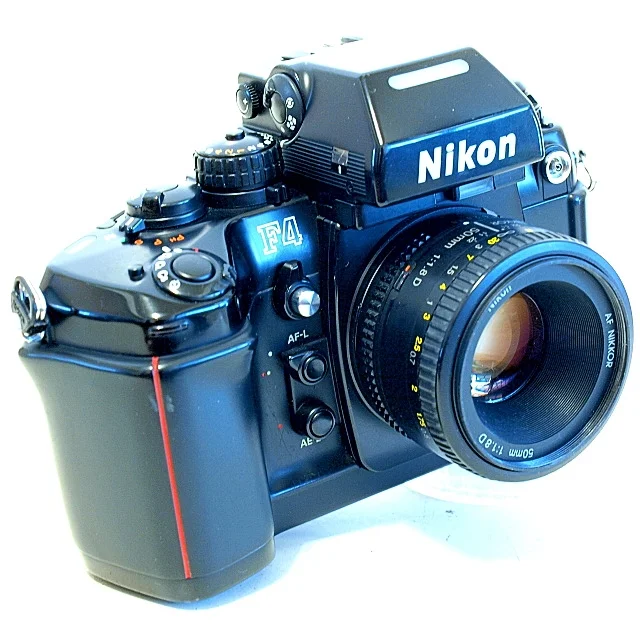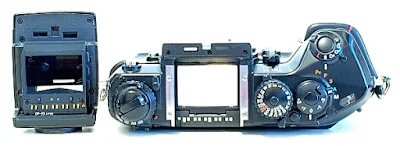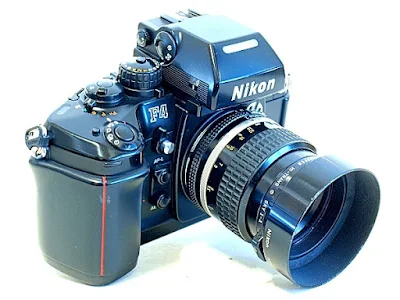The Vintage Enthusiast: A professional-grade autofocus 35mm SLR film camera from Nikon, taking on where the Nikon F3 left off.
There's probably not much more that can be written on the professional Nikon F4 35mm AF SLR camera, one of the best professional 35mm SLR film cameras ever built, that has not been covered by the likes of Wikipedia and websites like MIR.com, reviews by Ray Larose, Jake Horn Photography, Ken Rockwell, Dante Stella, and other streams of resources.
Designed by Giorgetto Giugiaro, the F4 was the choice for professionals as Nikon’s first fully supported autofocus camera comes with focus tracking capability. The camera supports just about every Nikon lens ever produced (with restrictions) and its Matrix metering is capable of supporting just about every Nikon flash unit available.
Operationally, the F4 is an autofocus 35mm SLR film camera fitted with an electromagnetically controlled vertical-travel focal-plane shutter with a stepless shutter speed range from 30 to 1/8000 second, plus B, T, and X. The camera accepts film speed range from ISO 25 to 5000 for DX-coded film and from ISO 6 to 6400 in 1/3 EV steps for manual setting.
Nikon F4 Video Instruction Manual 1 of 2
Nikon's F4 reimagined what a professional camera could -- and causally should -- be. The camera added innovations that Nikon had worked into previous, lower-...
Exposure is by Matrix Metering with the Multi-Meter Finder DP-20, Center-Weighted with the Multi-Meter Finder DP-20 or AE Action Finder DA-20, and Spot Metering with any finder. Shooting modes include S (single frame), CH (Continuous High speed), CL (Continuous Low speed), or Cs (Continuous silent). Flash synchronization, depending on the shooting mode used, is from 1/60 to 1/250 seconds.
Nikon F4, F4s, and F4e
Nikon ended up with three iterations of the F4, each identified by their AA-powered battery pack design which, incidentally, are interchangeable between the bodies without modification. The body itself went through a range of physical refinement throughout its production run, some of which are not obvious to the nondiscerning user. You can check this out at F4 Concise Instructions by Thom Hogan, look towards the bottom of the page at the section named Refinements to the F4.
The most compact is the F4, which holds 4 AA batteries housed in the grip. The F4s offer the MB-21 motor drive that uses 6 AA batteries and comes with an additional vertical shutter release button. The F4e (1991) incorporates the MB-23 motor drive unit, which features not only a 6 AA battery and a vertical release pack but also offers options for the Ni-Cd battery and an additional 250 exposure Bulk Film Multi-Control Back MF-24 terminal.
Build Quality and Handling
Built like a tank, the F4 has an aluminum-alloy body casing, heavy-duty electronics, and a rubber-cushioned exterior which does a bit in providing better water resistance. The F4 was the first professional Nikon to utilize a vertical-travel metal-blade shutter with a shutter balancer to minimize noise and camera bounce and is one of the three film-based Nikon cameras that offers full Matrix metering with AI manual focus lenses.
The fumble-free film-loading mechanism of the F4, though not uncommon among advanced SLR systems of the same era, adds to the ease of getting the camera ready, the film is advanced to frame 1 when you close the door. Rewind is either manual or motor-driven by holding down a pair of rewind toggle switches.
The F4 does not support Nikon's VR (Vibration Reduction) system, VR lenses will mount and function, but without image stabilization. The F4 also lacks the electronic aperture control system which will allow for the use of Nikon's G-type lenses, which are without aperture rings. With these lenses, exposure control is limited to program and shutter-priority modes.
Basic Camera Features
One trait commonly mentioned among the reviews is the transitional nature of the controls of the F4, where the electronics, LCD viewfinder display, autofocus, programmed auto-exposure, and matrix metering isareorward-looking, and its dedicated analog dials for shutter speed, lens aperture, metering pattern, and exposure compensation are reminiscent of the pedigree's mechanical beginning.
The Nikon F4 was the first of the F-series cameras that do not come with a manual film advance lever, the camera is based on a motor-driven system that lets you take your shots and advances the film automatically to the next frame. The system is also used to operate the film rewind (you can still rewind the film manually though).
Exposure metering on the F4 is available in 3 modes: Spot, Center-Weighted (80:20) as found on the Nikon F3, and the revolutionary Matrix mode, first seen in the Nikon FA which is a very efficient system for automatic exposure control, remote-control photography, and for fill-flash operation.
It is also worth mentioning that the Matrix metering mode is available on the F4 for all MF (Manual Focus) Nikkor lenses, something which you may not get on later Nikon models.
Shutter speeds are stepless from 30 sec. to 1/8000 sec. in Programmed Mode (PH, P) and Aperture-Priority Auto (A) modes, and set from 4 sec. to 1/8000 sec. in Shutter-Priority Auto (S) and Manual (M) modes, B, T, and X. Double-exposure is activated by pulling back a small behind the exposure comp dial before you take the shot, which will prevent the camera from advancing the film to the frame after the shutter is released.
Finder and Screen
The standard for the F4 is the DP-20 finder, where all three metering patterns are available. Alternatives are the AE Action Finder 20, with which you will miss out on the Matrix Metering option, and the 6X High Magnification DW-21 and Waist Level Finder DW-20, and miss out on both Matrix and Center-Weighted modes.
The F4 comes with an advanced B-type BriteView screen as the standard and a range of 12 other optional types.
Viewfinder Readout
With the DP-20 finder, the display is a plethora of picture-taking information organized within a horizontal display each above and below the s lining above and below the 100% field coverage screen.
The top display bar sports a couple of LCD screens to the left of the display for Exposure Compensation Value and (Additive) Frame Counter, an Aperture Direct Readout (ADR) window in the middle, and LED displays for Focus, Exposure Compensation, and Flash Ready Light indicators on the right.
The lower LCD bar displays the exposure readout which includes Metering, Shutter Speed, AE Lock, and Aperture settings.
LCD Bleed - An ailment commonly mentioned is the tendency of the units to bleed, something which you might want to look into or inquire about units that are for sale. The camera will still work, nevertheless.
Film Advance Modes
Film advance mode is controlled by a dial integrated with the shutter button. Turning the dial from its Lock position to any of the selections available requires a small knob adjacent to the dial to be pressed before the dial can be turned. The self-timer selection is part of the dial:
- L (Lock) - Immobilizes the camera.
- S (Single Frame) - Single-frame shot for each exposure.
- CH (Continuous High Speed) - Continuous, at 4 to 5.7 fps, depending upon the battery pack used.
- CL (Continuous Low Speed) - Continuous, at 3 to 3.4 fps, depending upon the battery pack used.
- CS (Continuous Silent) - Continuous, at 0.8 to 1 fps, depending upon the battery pack used.
- Self-Timer - 10-second delay, self-timer activates the autofocus and light meter operation.
Focus Modes
The focus mode selector, located on the front panel of the camera body, located just below the lens release knob, enables the following selection:
- S (Single Servo AF) - Uses focus-priority (shutter cannot be released until focus is achieved).
- C (Continuous Servo AF) - Uses release priority (shutter can be released whether or not focus is achieved). Image focusing is continuously updated unless the AF-L button is held down (which will lock focus).
- M (Manual Focus) - Electronic confirmation symbols appear in the viewfinder.
Shooting Modes
The shooting mode selector, located on the top of the camera slightly back from the shutter dial, is the PASM center of the F4, and comes with the addition of a PH selection::
- PH (High-Speed Program) - The camera sets both the shutter speed and aperture with an emphasis on faster shutter speeds; requires AF or AI-P lens.
- P (Program) - The camera sets both the shutter speed and aperture; it requires an AF or AI-P lens.
- S (Shutter-Priority) - You set the shutter speed, and the camera sets the aperture; requires an AF or AI-P lens.
- An (Aperture-Priority) - You set the aperture, and the camera sets the shutter speed.
- M (Manual) - You choose both the aperture and the shutter speed.
Batteries
The F4 can be used with both Alkaline-Manganese (LR6) and NiCD batteries. At a normal operating temperature of 20°C, the High-Speed Battery Pack MB21 can be used for up to 90 rolls of 36 exposure film rolls with Alkaline-Manganese (LR6) batteries, and up to 70 rolls of 36 exposure film rolls with NiCD batteries.
With the Battery Pack MB20, the F4 can be used for up to 30 rolls of 36 exposure film rolls with a set of Alkaline-Manganese (LR6) batteries.
At lower operating temperatures, the number of film rolls that can be powered by a set of batteries will be reduced considerably.
Battery Check
Battery power for the operation of the F4 is sufficient if the viewfinder LCD appears when the shutter release button is lightly pressed and remains on for approximately 16 seconds after the pressure is released. The battery power is insufficient and needs to be replaced if the LCD turns off immediately after the finger is removed from the shutter release button.
The batteries are exhausted or improperly loaded if no data appears and the shutter does not operate.
Camera Body Weight
The F4's body weight, with Battery pack MB20, is approximately 1090 grams, while with the High-Speed MB21, it is approximately 1280 grams.
Using The Camera
Beefy as it is, the ergonomics of the F4 are reassuringly comfortable in your hands, with that rock-solid feeling that nothing can go wrong. The shutter button is right as it should be, and the Film Advance Mode dial, though not as easy as using the Shooting Mode dial, might be slightly awkward to adjust with your thumb and index finger.
The AF and AE Locks are two separate buttons, placed on the front panel of the camera body, which are easy to reach with your fingertips.
Film loading is a quick drop and pop, needing you only to extend the film lead and align it with the red square etched on the film box frame before closing the film back. Unloading is just as quick, just hold the two rewind levers down and the film will roll itself back into the canister in a few seconds.
Besides using an AF Nikkor 50mm f/1.8 D with the F4, which makes shooting almost a point-and-shoot experience, I have also used the F4 with a Nikkor 85mm f/2 Ai-S. This adds a bit more weight to the body, shooting is now a full two-handed operation, but hold and behold, I found myself a new best friend, the electronic rangefinder system.
EndNote
In retrospect, the Nikon F4, with its ease of use of mechanical buttons, dials, and levers, is still of the old school, distinct from the digital buttons and menu selection styles of, say, the Nikon F90x/N90S which I also wrote about. The F4 is an exciting end to an era, one which will remain steadfastly one of the best of the breed, and an equally outstanding example of the AF analog camera systems.
While I am still on the lookout for other Nikon AF bodies to add to my collection for the Introduction and Overviews sessions, I am sure you will find the F4 still as exciting to own and use as the professionals before you.
























Nice
ReplyDeleteThank you
Delete